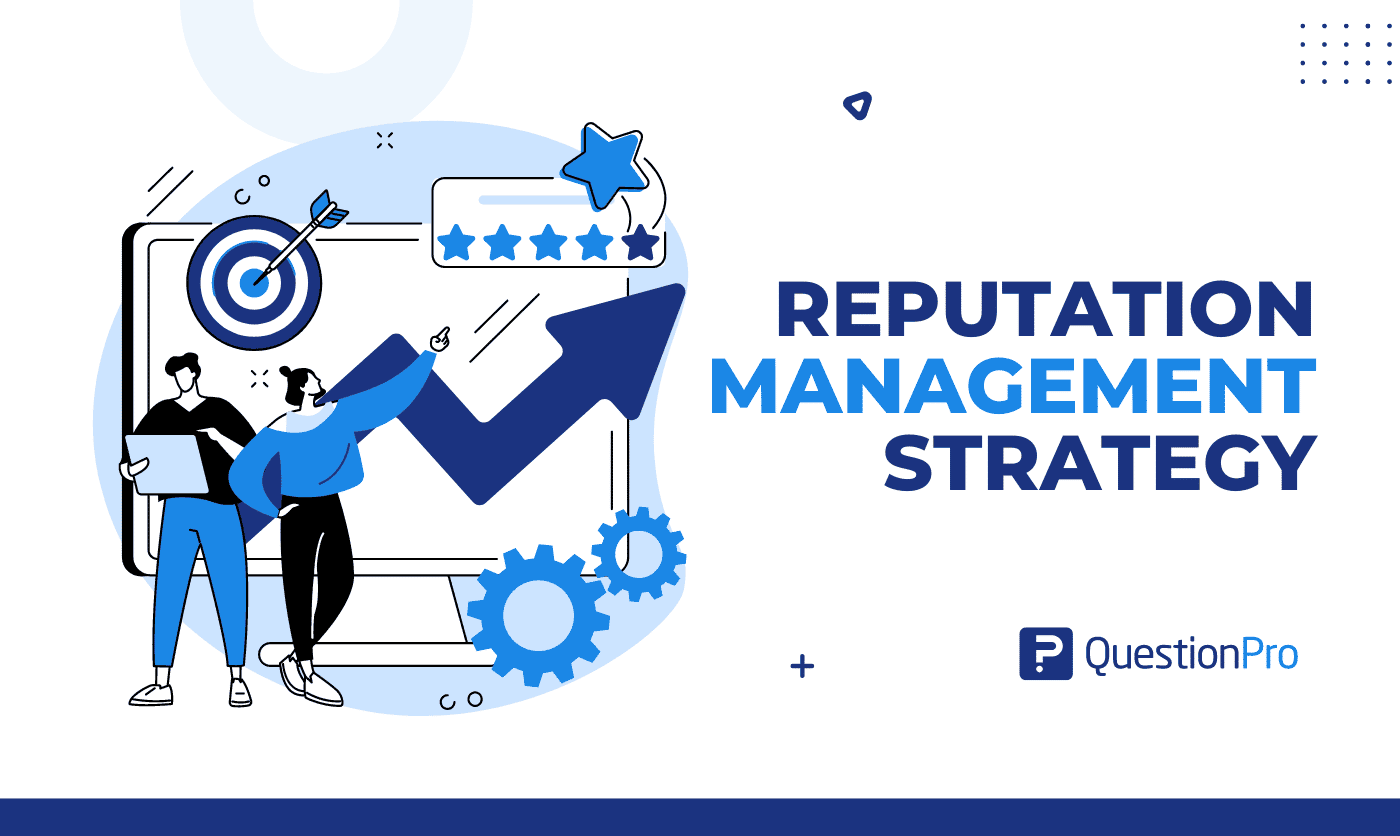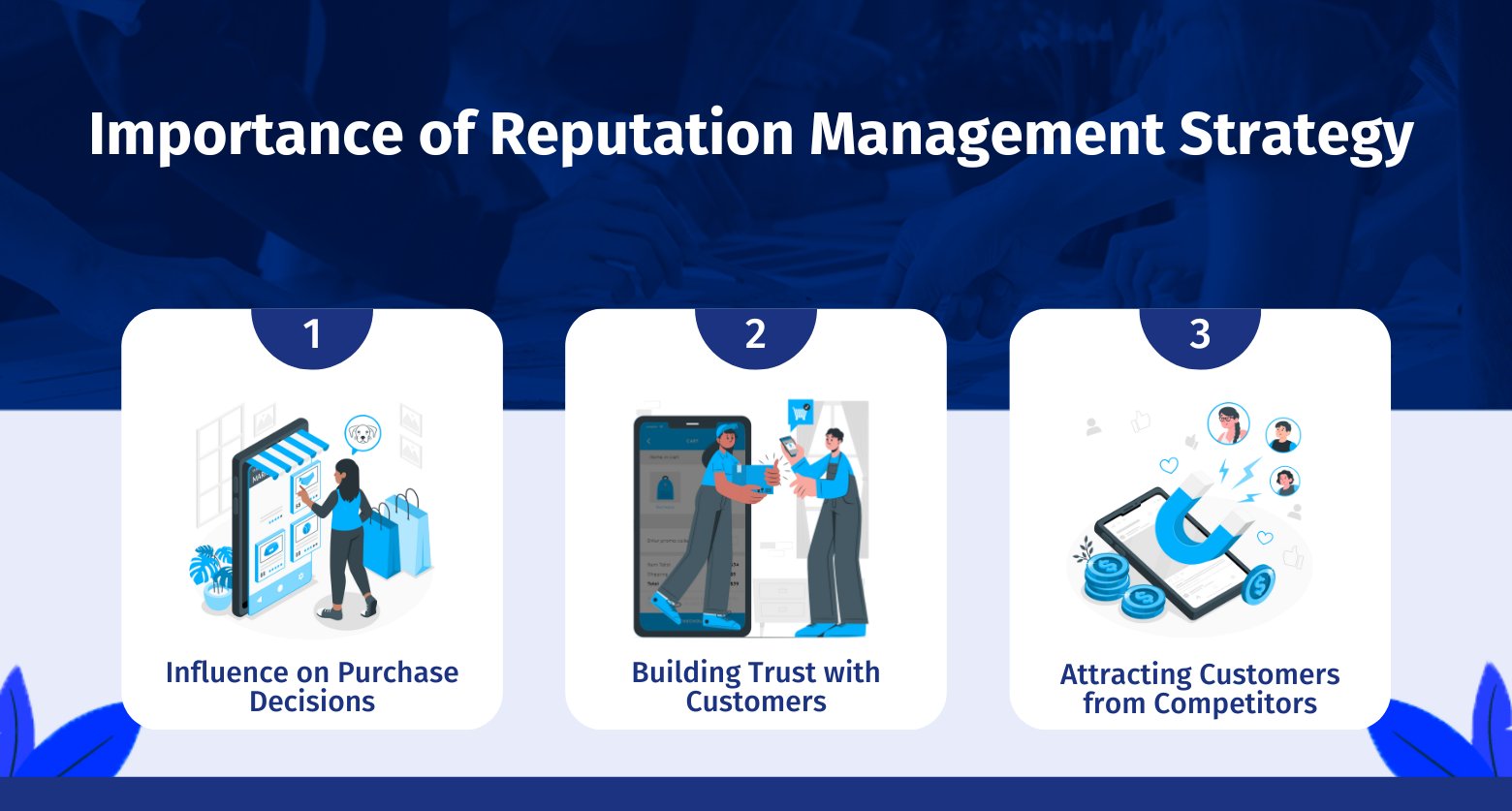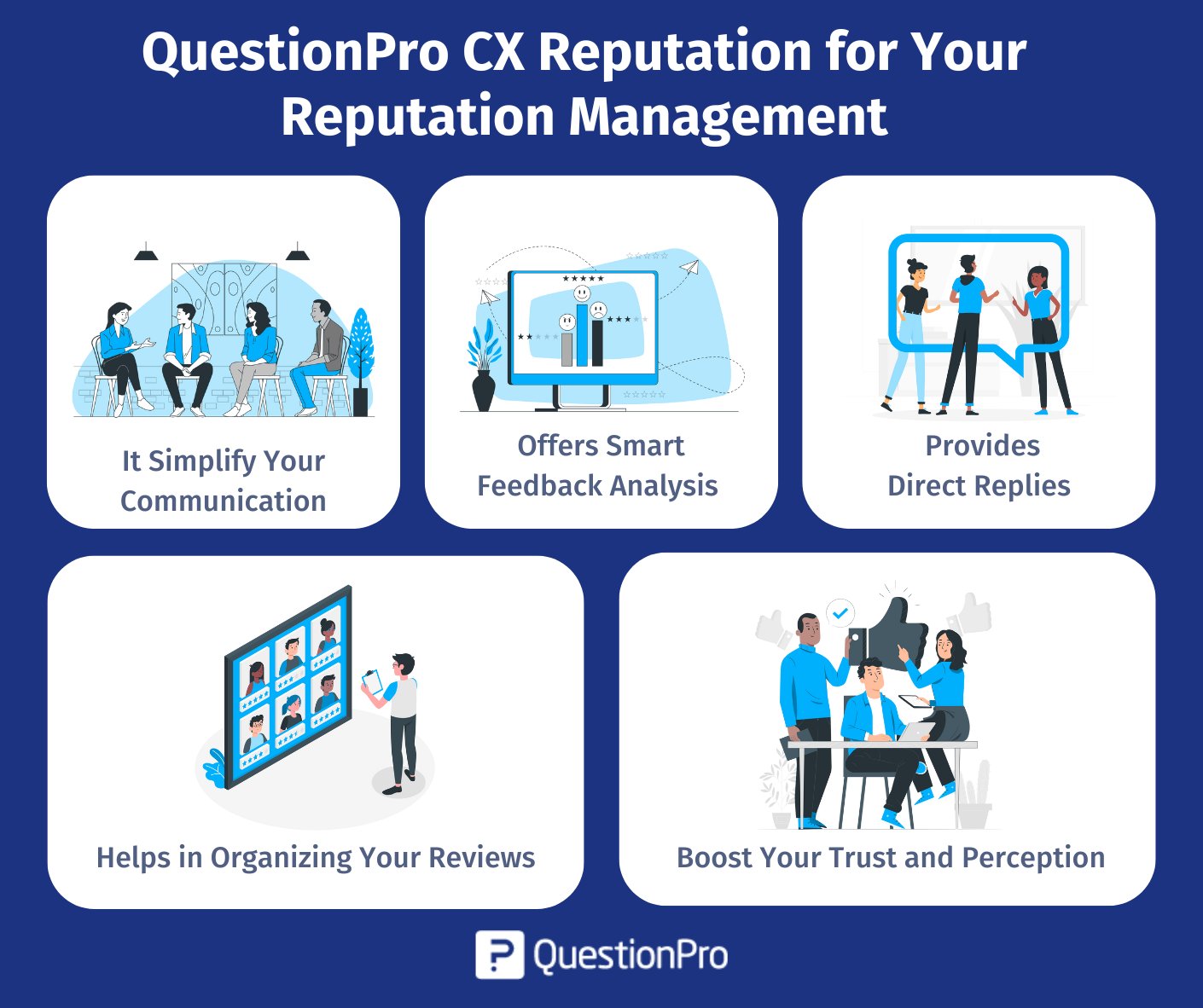
Managing your brand’s reputation is more important than ever. If customers are unhappy with a product or service, they can easily share their complaints online for everyone to see. That’s why it’s important to have a strong reputation management strategy.
An online reputation management strategy helps businesses handle these situations and their impact. By staying on top of what people are saying about your brand, you can understand customer feelings and reduce negative comments, which helps protect your business’s image.
In this blog, we’ll learn the steps to create a solid reputation management plan. From monitoring what people say about your brand to handling negative feedback, you’ll learn how to protect and improve your brand’s image.
What is a Reputation Management Strategy?
A reputation management strategy is a process of managing a person’s, company’s, or brand’s online narrative. It is part of monitoring views and conversations, dealing with reputation threats, and proactively taking opportunities to improve brand image.
Reputation management entails more than merely responding to comments on websites and social media platforms. It’s essential to understand how people view your brand and plan future efforts to change that perception.
Although details of the strategy are provided below, it essentially revolves around the following two ideas:
- Monitoring: Keep an eye on the market to find out what consumers, opinion leaders, and rival businesses are saying about your brand.
- Responding: React by doing something to change people’s perceptions of you and your brand.
Let’s now discuss the importance of an online reputation management strategy and why your brand should treat it seriously.
Importance of Reputation Management Strategy
It’s important to have a reputation management strategy in place for your business. Now, let’s talk about the specifics.

Influence on Purchase Decisions
Brand reputation plays a significant role in how customers make buying choices. Potential customers often check reviews before deciding to buy. Even if your products and customer service are top-notch, a few negative comments can scare them away and lead them to explore better options.
Building Trust with Customers
Negative reviews can shake people’s trust in your brand and make them reconsider their loyalty. When customers see poor ratings, they may seek out alternatives. On the other hand, positive reviews can boost their confidence in your brand, highlighting the importance of a strong reputation management strategy.
Attracting Customers from Competitors
A positive brand image can help you stand out from the competition. To achieve this, you need to be aware of your online reputation and that of your rivals. Happy customers who share their positive experiences can draw others to your brand, making it essential to cultivate a strong reputation.
How to Create an Online Reputation Management Strategy?
To manage your reputation strategically, you need to create a plan that considers your existing circumstances, available resources, and desired outcomes. Here is a step-by-step guide on online reputation management strategy to assist reputation management companies in understanding the essentials.
Step 1: Monitor your current brand reputation
Every good thing begins with an analysis of the current scenario. Tracking your brand reputation on the web is integral to any effective reputation management strategy. Start to monitor your online reputation on the:
- App Stores
- Social Media
- Review Sites
- eCommerce Sites
Additionally, you need to care about forums, blogs, and news websites. Everywhere, people express their views about brands. Knowing where your customers are, is crucial. You can determine this based on the product or service you sell.
Step 2: Analyze your business competitor
Understanding your competitors’ reputations is the next stage in developing a reputation management strategy. A comparative analysis looks at how your competitors handle ratings, reviews, comments, and mentions across all channels.
Developing a reputation management strategy aims to increase your brand’s reputation rather than compare it to your competitors.
The competitive analysis offers two significant advantages:
- You will learn about the problems that your competitors’ customers are having.
- You can learn from the mistakes made by your competitors if you pay attention to customer feedback.
Through this analysis, you will gain knowledge and an understanding of the dos and don’ts of responding to customer reviews.
Step 3: Develop an actionable plan
The next step is to create an actionable plan to build your reputation. Your team’s responsibilities should be distributed in your action plan.
Please consider the following:
- Who will track the feedback and reviews?
- Who will be in charge of whether fresh comments demand a response?
- Who has the expertise to determine the company’s position on potential problems or inquiries?
- Who will provide the answers?
Just make sure you’ve given these items some thought before getting started. If things start to go wrong, you’ll have the plan to fall back on as long as you have one.
Now assign the tasks into the following categories to your team based on the learnings from the competitor analysis and brand monitoring stage:
- Negative comments
- Spam remarks
- Fake comments
- Positive comments
- Business-related questions
Managing online reviews can be tricky, but our guidance will help you tackle them with confidence. Whether you’re facing negative feedback, fake reviews, or positive comments, having a plan is key to keeping your brand’s reputation strong. Here’s a bunch of tips for you:
How to handle negative reviews?
- Don’t take negative reviews personally.
- Never overlook a negative review, as this will make things worse.
- As you speak on behalf of a reputation management company, be courteous in your responses.
- Quickly respond to negative evaluations but don’t always do so similarly.
- Ask the reviewer to get in touch to transfer the discussion to a private forum.
How to deal with fake reviews?
- Keep yourself calm and try not to take the review personally.
- Try to have the review deleted.
- Even though you know the review could be fake, don’t respond that way.
- Ask the reviewer about their difficulties and for specifics.
- Be cautious of fake reviews. If you answer to some but not others, potential customers will think you’re a fraud.
How do you handle positive reviews?
- Share excellent reviews on social media.
- Thank them for sharing the review. I am grateful.
- Address them by their first name, giving them a more personal touch.
- Be quick and clear with your reply.
- Promote the mission of your business.
- Call them to review, visit, or download your app for offers.
- Arrange a reputation management campaign
You can be sure the review will be favorable if you know you provided good service. Additionally, if the customer receives a personal request, they are more motivated to make an extra effort to help. Remember that encouraging constructive feedback is essential to develop a solid reputation.
Step 4: Monitor and control the reviews
You must have a system to keep track of and manage your discussions while responding to online reviews. You may employ review websites and tools in addition to your business’s website and social media accounts to keep track of all customer evaluations and brand mentions.
Start with one of the tools listed below and begin managing your reviews.
- QuestionPro CX Reputation
- Mention
- Reputology
- Statusbrew
- Google My Business
Step 5: Measure your results
Last but not least, after implementing your reputation management strategy, you should evaluate your success and continue to expand on your successes.
Having recognized the value of tracking your success, let’s focus on a few metrics you should monitor to understand the evolution of your brand’s reputation.
- Sentiment Analysis: It’s encouraging to see activity about your business on review websites. Knowing the percentage of it that is positive is preferable.
You can analyze the reviews’ sentiment using reputation management tools. QuestionPro CX Reputation is an excellent choice for sentiment analysis.
- Media and industry mention: If you’re getting more top-tier media mentions, you’re on the correct route. Industry leaders and influencers may tag your brand, influencing how people see your brand and boosting sales.
- Share of Voice: It compares your brand awareness to that of your competitors. You ought to see a noticeable change in this statistic over time.
Top business reputation management software for managing your brand
Reputation management software helps you keep track of what people are saying about your brand online and makes it easier to protect your image. Instead of manually searching for reviews, comments, or mentions, reputation management software does the hard work for you. It monitors social media, review sites, and other online platforms so you can quickly spot any negative feedback and respond before it damages your reputation.
Here are some great tools to help you stay on top of what people are saying about your business:
- 1. Brand24: This online reputation management tool keeps an eye on social media, blogs, and news sites for any mentions of your brand in real-time. It helps you quickly respond to any negative comments and understand how people feel about your brand.
- 2. Reputation.com: It lets you track reviews and feedback in one place, helping you respond to customer comments and improve your online ratings over time.
- 3. Hootsuite: While it’s mainly for social media management, Hootsuite also lets you monitor brand mentions across different platforms so you can jump in and respond quickly when needed.
- 4. Yext: Yext helps you manage your brand’s information across review sites and directories, ensuring everything is accurate and making it easier to respond to feedback from one dashboard.
- 5. Birdeye: This online reputation management software helps you collect and respond to customer reviews while also giving you insights to understand customer experiences and strengthen your brand’s reputation.
Why Use QuestionPro CX Reputation for Your Reputation Management?
QuestionPro CX Reputation is an essential tool for businesses aiming to manage and enhance their online reputation effectively. Here’s why you should consider using it:

It Simplify Your Communication
QuestionPro CX Reputation allows your team to easily respond to comments and reviews across various social media platforms and public review sites. This centralized communication makes it simple to engage with customers, address their concerns, and show that you value their feedback, all from one convenient dashboard.
It Offers Smart Feedback Analysis
With advanced AI sentiment analysis, the tool processes customer feedback and reviews to help you quickly identify any issues or trends. By understanding how customers feel about your brand, you can make informed decisions to resolve problems.
QuestionPro Provides Direct Replies
One of the standout features of CX Reputation is the ability to respond to reviews and comments directly from the platform. This means you can address customer feedback promptly. The tool even includes automated translation for reviews in different languages.
Helps in Organizing Your Reviews
The software provides powerful organization tools that allow you to:
- Import and export reviews
- Monitor customer feedback efficiently and
- Assign tasks to team members
This structured approach ensures that no feedback slips through the cracks and helps your team stay on top of customer concerns.
QuestionPro Boost Your Trust and Perception
Actively engaging with customers through timely responses to their feedback not only addresses their concerns but also builds trust in your brand. By Showing that you care about customer opinions, you can significantly improve your brand’s overall perception. This trust can turn doubtful supporters into loyal supporters.
Conclusion
Improving a company’s public perception is one of the goals of an effective reputation management strategy. You can’t just hope for the best in managing your reputation. You need to keep an eye on what others are saying about you and interact with them to continue the conversation positively.
So, now is the time, and start working. You now know how to create an effective reputation management strategy. Write up guidelines and other papers to ensure your team has all the necessary instructions. Try hard and be patient.
With the help of QuestionPro CX Reputation, your team can collect feedback, conduct AI-powered sentiment analysis, and reply to comments across essential public reviews and social media sites, all in real-time.
Frequently Asked Questions (FAQs)
Key elements include monitoring brand mentions across platforms, addressing negative reviews or feedback promptly, encouraging positive reviews, maintaining transparency with customers, and using data insights to improve products or services. AI tools and sentiment analysis also help track public perception and respond effectively.
When dealing with negative reviews, respond quickly, professionally, and politely. Avoid being defensive and try to resolve the issue by inviting the customer to discuss their concerns privately. This shows you value their feedback and are willing to address their problems, which can help turn a negative experience into a positive one.
Actively managing your reputation by responding to customer reviews, both positive and negative, shows that you care about your customers’ experiences. This transparency helps build trust because customers see that you are committed to improving their experience and addressing their concerns.







